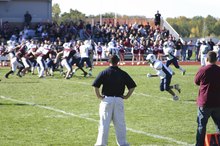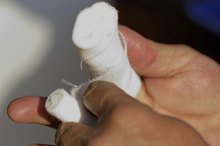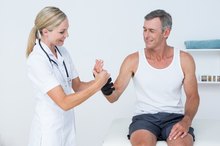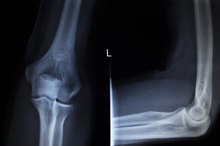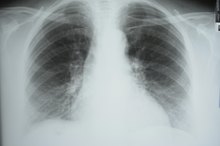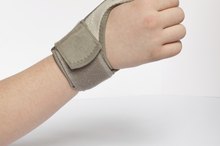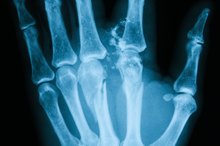What does fact checked mean?
At Healthfully, we strive to deliver objective content that is accurate and up-to-date. Our team periodically reviews articles in order to ensure content quality. The sources cited below consist of evidence from peer-reviewed journals, prominent medical organizations, academic associations, and government data.
- Hand: Index Radial Collateral Ligament Repair with Titanium Mini-Suture Anchor -- Osteolysis Complication of an Underreported Injury
- Hand: Index Radial Collateral Ligament Repair with Titanium Mini-Suture Anchor -- Osteolysis Complication of an Underreported Injury
- BMC Musculoskeletal Disorders: Self Management, Joint Protection and Exercises in Hand Osteoarthritis -- A Randomised Controlled Trial with Cost Effectiveness Analyses
- BMC Musculoskeletal Disorders: Self Management, Joint Protection and Exercises in Hand Osteoarthritis -- A Randomised Controlled Trial with Cost Effectiveness Analyses
- Indian Journal of Orthopaedics: Double Parabolic Kirschner-Wires as Dynamic Distractor for Treatment of Unstable Intraarticular Phalangeal Fractures of Hand
- Indian Journal of Orthopaedics: Double Parabolic Kirschner-Wires as Dynamic Distractor for Treatment of Unstable Intraarticular Phalangeal Fractures of Hand
The information contained on this site is for informational purposes only, and should not be used as a substitute for the advice of a professional health care provider. Please check with the appropriate physician regarding health questions and concerns. Although we strive to deliver accurate and up-to-date information, no guarantee to that effect is made.
What Causes Finger Joint Pain?
Finger joint pain can significantly impact your daily life, making it difficult to get dressed, drive and type. Sometimes the cause of your pain may be obvious, particularly if you have a traumatic injury. In other cases, pain develops gradually, and the cause may not be apparent. See your doctor for an accurate diagnosis of your finger joint pain.
If you are experiencing serious medical symptoms, seek emergency treatment immediately.
Ligament Strain
Ligaments are strong fibers that connect one bone to another. Strains occur when your finger is forced too far in one direction, damaging the ligaments on the opposite side. This injury, commonly called a "jammed finger," initially causes sharp pain. Swelling often develops soon after injury, and you may see some bruising. Movement of the finger is limited due to swelling and pain. Severe ligament strains can cause tearing of the fibers and may require surgery 1.
- Ligaments are strong fibers that connect one bone to another.
- Severe ligament strains can cause tearing of the fibers and may require surgery 1.
Arthritis
Can You Play Football with a Fractured Finger?
Learn More
Arthritis frequently causes finger joint pain. Osteoarthritis develops when cartilage -- padding between your bones -- wears down. Eventually your bones may rub together as you move your finger, causing sharp pain. At rest, you may have aching pain in your finger joints. This condition may affect one or more joints in your fingers.
Rheumatoid arthritis, an inflammatory condition that causes your body to mistakenly attack healthy joint tissue, typically affects multiple finger joints at the same time. Pain increases with activity and may decrease with rest. Arthritis pain may be treated with medications and activity modification.
- Arthritis frequently causes finger joint pain.
- Arthritis pain may be treated with medications and activity modification.
Tendon Injury
Tendons connect muscle to bone. There are no muscles in your fingers, but long tendons that attach to muscles run along the front and back of each finger. Tendons attach close to each finger joint, and injury to these structures can cause joint pain 1. These injuries are typically caused by trauma or lifting something that is too heavy. Swelling, bruising and stiffness may accompany a finger tendon injury. Seek immediate medical attention if you're unable to bend or straighten your injured joint. This may indicate a torn tendon, which requires timely surgical repair.
- Tendons connect muscle to bone.
- Seek immediate medical attention if you're unable to bend or straighten your injured joint.
Bone Fracture
Causes of Wrist and Elbow Joint Pain
Learn More
Bone fractures are typically caused by trauma, such as slamming your finger in a door. These injuries immediately cause sharp pain, and your finger may appear deformed. Swelling and bruising often occur soon after the injury. However, finger fractures may not always be obvious. Ligament and tendon injuries may cause a chip fracture, breaking off a small piece of bone where these structures were once attached 1. You may have difficulty moving the injured joint. These fractures often require surgery to make sure the bones heal in the proper position, preserving joint function.
- Bone fractures are typically caused by trauma, such as slamming your finger in a door.
- These fractures often require surgery to make sure the bones heal in the proper position, preserving joint function.
Related Articles
References
- Hand: Index Radial Collateral Ligament Repair with Titanium Mini-Suture Anchor -- Osteolysis Complication of an Underreported Injury
- BMC Musculoskeletal Disorders: Self Management, Joint Protection and Exercises in Hand Osteoarthritis -- A Randomised Controlled Trial with Cost Effectiveness Analyses
- Indian Journal of Orthopaedics: Double Parabolic Kirschner-Wires as Dynamic Distractor for Treatment of Unstable Intraarticular Phalangeal Fractures of Hand
- Van veenendaal LM, De klerk G, Van der velde D. A painful finger as first sign of a malignancy. Geriatr Orthop Surg Rehabil. 2014;5(1):18-20. doi:10.1177/2151458514522125
- Oetgen ME, Dodds SD. Non-operative treatment of common finger injuries. Curr Rev Musculoskelet Med. 2008;1(2):97-102. doi:10.1007/s12178-007-9014-z
- Prucz RB, Friedrich JB. Finger joint injuries. Clin Sports Med. 2015;34(1):99-116. doi:10.1016/j.csm.2014.09.002
- Christensen T, Sarfani S, Shin AY, Kakar S. Long-term outcomes of primary repair of chronic thumb ulnar collateral ligament injuries. Hand (N Y). 2016;11(3):303-309. doi:10.1177/1558944716628482
- Spies CK, Langer M, Hahn P, Müller LP, Unglaub F. The treatment of primary arthritis of the finger and thumb joint. Dtsch Arztebl Int. 2018;115(16):269-275. doi:10.3238/arztebl.2018.0269
- Deveza LA, Hunter DJ, Wajon A, et al. Efficacy of combined conservative therapies on clinical outcomes in patients with thumb base osteoarthritis: protocol for a randomised, controlled trial (COMBO). BMJ Open. 2017;7(1):e014498. doi:10.1136/bmjopen-2016-014498
- Makkouk AH, Oetgen ME, Swigart CR, Dodds SD. Trigger finger: etiology, evaluation, and treatment. Curr Rev Musculoskelet Med. 2008;1(2):92-6. doi:10.1007/s12178-007-9012-1
- Alla SR, Deal ND, Dempsey IJ. Current concepts: mallet finger. Hand (N Y). 2014;9(2):138-44. doi:10.1007/s11552-014-9609-y
Writer Bio
Dr. Bailey is a physical therapist with an additionaldegree in psychology and board certification in hand therapy. She is a Level 1CrossFit Coach and former ACSM certified personal trainer. Dr. Bailey is alsoan Anatomy and Physiology professor and has been writing health and fitnessarticles for over 10 years.
